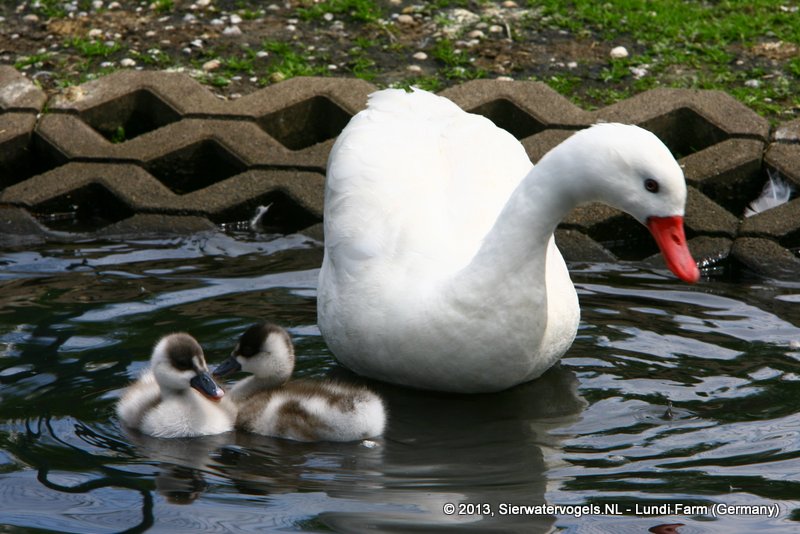
Coscoroba Swan (Coscoroba coscoroba)
Species name
- Dutch name:
- Coscoroba zwaan
- English name:
- Coscoroba Swan
- German name:
- Coscorobaschwan
- French name:
- Coscoroba blanc
- Scientific name:
- Coscoroba coscoroba
Scientific classification
- Order:
- Anseriformes
- Family:
- Anatidae
- Onderfamilie:
- Anserinae
- Genus:
- Coscoroba
Description
- Description:
Male:
Have white plumage except for black tips to the outer six primary feathers, although this black is often barely visible on the closed wing. In flight, the black wing tips are conspicuous. The bird has a red beak, legs and feetFemale:
Looks almost identical to the male. But is slightly smaller.Cygnet/Juvenile:
White with brownish pattern on head and upperparts.
- Behaviour:
Found in flocks, usually less than 100 birds, outside the breeding season. Territorial while breeding. Forage in shallow water and also graze along the water's edge.
Standard Measurements
- Body Length (cm):
- The male (drake) of the Coscoroba Swan measures approximately 86-115 centimeters. The female measures approximately 86-115 centimeters.
- Body Weight (grams):
- The male will weight about 3800-5400 gram. The female will weight about 3200-4500 gram.
The weight is notoriously variable and can only be used as indication!
- Note:
Coscoroba swans require large area of high-quality, preferably running, water and a good grazing area. Coscorobas are more delicate than most swans and natural and/or artificial shelter should be provided for protection in severe weather.
This species is less aggressive than most of the swans and they are not generally aggressive outside the breeding season, but they are usually more aggressive and territorial during nesting season (some individuals are more aggressive than others). It may be possible to keep more than one pair in a large enclosure (e.g. three pairs reported to be kept successfully in a one hectare enclosure); in smaller enclosures they may or may not tolerate other species, depending on the temperament of individual birds.
Coscorobas are bred sporadically rather than easily, but established pairs usually continue breeding once they have started. Eggs are laid on a large pile of vegetation, laying usually occurring from early April to the end of May. They frequently lay a second clutch if the first clutch is removed or if the cygnets are removed soon after hatching; they may lay a third clutch particularly if they are not allowed to incubate their previous clutches. Cygnets may be parent incubated and hatched, or parent incubated until just before hatching then hatched in an incubator and hand-reared. These swans are not always good sitters - artificial incubation and hand rearing may be required; they may also be broody hatched and reared. Cygnets are easy to rear on Lundi Premium. Whether broody or hand reared, fresh clean turf and protection from draughts and rain should be provided.
Coscoroba swans do not appear to hybridise.
- Breeding:
- The female Coscoroba Swan usually lays from 5-9 whitish cream eggs and incubates them for 32-35 days.
- Artificial incubating:
The ideal relative humidity for incubating most waterfowl eggs is 55% (ground nesters) and 40% (cavity nesters). The temperature is usually 37.4°C. Set ventilation as recommended by the incubator manufacturer. Eggs must be turned, either automatically or by hand, a minimum of 4 times a day. As the duckling develops there is a loss of water from the egg and the air sac gets bigger. In normal development of an egg with a 32-35 days incubation, the air sac occupies about a third of it three days earlier. Cleanliness is vital and ideally eggs should be moved to a separate hatcher at this point, where the humidity should be increased to 65% and even higher once they have pipped internally.
- Bird banding:
- Recommended closed leg band ring size for the Coscoroba Swan is 20 mm.The leg band ring can only be applied on a young swan at around 14-16 days old.
- It doesn't matter what leg that you band, but it's good to have a consistent system. Suggested: Left leg = Female, Right leg = Male
- Maintenance food:
-





Floating full food for all sea ducks, green ducks, eider ducks and geese, especially in the moulting and breeding phase ideally suited. Packed with wholesome raw materials, natural vitamins and trace elements, this performance food with a protein content of 30% forms the basis for lifelong vitality.
- Regulation:
CITES II (B1)


